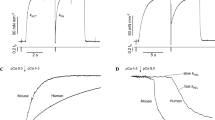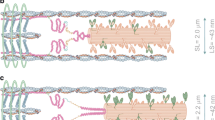Abstract
The contraction of cardiac muscle is the end result of several steps that constitute excitation-contraction coupling: action potential, entry of Ca2+ ions through the surface membrane, release of Ca2+ ions from intracellular stores (sarcoplasmic reticulum), binding of Ca2+ to the C subunit of the regulatory protein troponin on the thin filament, conformational changes in the thin filament to uncover the myosin binding sites on actin molecules, the binding of myosin heads of actin through the formation of myosin cross-bridges, and finally, motion of cross-bridges that result in force development and/or shortening. The detailed study of each of the above mentioned steps has become almost a field of investigation of its own. There is increasing evidence for the existence of several feedback loops between steps in excitation-contraction coupling, of which only a few will be mentioned in this chapter. Mechanical events such as changes in length alter the characteristics of both the action potential1–4 and of the intracellular Ca2+ transient4–7 detected with the Ca2+-regulated photoprotein aequorin8. The purpose of this brief review is to highlight the observations that changes in load or of force development influence the time course of the intracellular calcium transient in isolated cardiac muscle. It will become apparent that it is often not possible to distinguish between changes of length and of force as the primum movens for the observed changes in the intracellular calcium transient.
Access this chapter
Tax calculation will be finalised at checkout
Purchases are for personal use only
Preview
Unable to display preview. Download preview PDF.
Similar content being viewed by others
References
Allen DG and Kentish JC (1985). The cellular basis of the length-tension relation in cardiac muscle. J Mol Cell Cardiol 17: 821–840.
Kaufmann RL, Lab MJ, Hennekes R and Krause H (1971). Feedback interaction of mechanical and electrical events in the isolated mammalian ventricular myocardium (cat papillary muscle). Pflugers Arch 324: 100–123.
Hennekes R, Kaufmann RL and Lab MJ (1981). The dependence of cardiac membrane excitation and contractile activity on active muscle shortening (cat papillary muscle). Pflugers Arch 392: 22–28.
Lab MJ, Allen DG and Orchard CH (1984). The effects of shortening on myoplasmic calcium concentration and on the action potential in mammalian ventricular muscle. Circ Res 55: 825–829.
Allen DG, Cannell MB, Lab JM and Orchard CH (1983). Shortening during contraction slows the calcium transient in cat papillary muscle. J Physiol (London) 334: 108P–109P.
Housmans PR, Lee NKM and Blinks JR (1983). Active shortening retards the decline of the intracellular calcium transient in mammalian heart muscle. Science 217: 159–161.
Blinks JR, Lee NKM and Housmans PR (1983). Shortening deactivation in frog skeletal muscle is not associated with abbreviation of the intracellular calcium transient. Fed Proc 42: 569.
Blinks JR, Wier WG, Hess P and Prendergast FG (1982). Measurements of Ca2+ concentrations in living cells. Prog Biophys Mol Biol 40: 1–114.
Brutsaert DL, Housmans PR and Goethals MA (1980). Its role in the ventricular function in the mammalian heart. Circ Res 47: 637–652.
Housmans PR and Murat I. Comparative effects of halothane, enflurane, and isoflurane at equipotent anesthetic doses on isolated ventricular myocardium of the ferret. Anesthesiology (in press).
Poggesi C, Reggiani C, Ricciardi L and Minelli R (1982). Factors modulating the sensitivity of the relaxation to the loading conditions in rat cardiac muscle. Pflugers Arch 394: 338–346.
Poggesi C, Reggiani C, Bottinelli R, Ricciardi L and Minelli R (1983). Relaxation in atrial and ventricular myocardium: activation decay and different load-sensitivity. Basic Res Cardiol 78: 256–265.
Lecarpentier YC, Chuck LHS, Housmans PR, De Clerck NM and Brutsaert DL (1979). Nature of load dependence of relaxation in cardiac muscle. Am J Physiol 237: H455–H460.
Jewell BR and Wilkie DR (1960). The mechanical properties of relaxing muscle. J Physiol (London) 152: 30–47.
Bahler AS (1971). Mechanical properties of relaxing frog skeletal muscle. Am J Physiol 220: 1983–1990.
Ridgway EB and Gordon AM (1984). Muscle calcium transient: effects of poststimulus length changes in single fibers. J Gen Physiol 83: 75–103.
Bremel RD and Weber A (1972). Cooperation within actin filaments in vertebrate skeletal muscle. Nature PBbBbPNew Biology 238: 97–101.
Blinks JR and Endoh M (1986). Modification of myofibrillar responsiveness to Ca2+ as an inotropic mechanism. Circulation 73 (Suppl III): 85–97.
Allen DG and Kentish JC (1985). The effects of length changes on the myoplasmic calcium concentration in skinned ferret ventricular muscle. J Physiol (London) 336: 67P.
Hofmann PA and Fuchs F (1985). Effect of length and cross-bridge attachment on Ca2+ binding to cardiac troponin C. Am J Physiol 253: C90–C96.
Hofmann PA and Fuchs F (1986). Evidence for a force dependent component of Ca2+ binding to cardiac troponin C. Biophys J 49: 84.
Pan BS and Solaro RJ (1987). Calcium-binding properties of troponin C in detergent-skinned heart muscle fibers. J Biol Chem 262: 7839–7849.
Moss RL, Allen JD and Greaser ML (1986). Effects of partial extraction of troponin complex upon the tension-pCa relation in rabbit skeletal muscle. Further evidence that tension development involves cooperative effects within the thin filament. J Gen Physiol 87: 761–774.
Nichols CG (1985). The influence of ‘diastolic’ length on the contractility of isolated cat papillary muscle. J Physiol (London) 361: 269–279.
Hanck DA and Jewell BR (1985). Effects of physiological beating on the contractility of cat ventricular muscle. Am J Physiol 248: H894–H900.
Parmley WW, Brutsaert DL and Sonnenblick EH (1969). Effects of altered loading on contractile events in isolated cat papillary muscle. Circ Res 24: 521–532.
Jewell BR and Rovell JM (1973). Influence of previous mechanical events on the contractility of isolated cat papillary muscle. J Physiol (London) 235: 715–740.
Housmans PR, Lee NKM and Blinks JR (1983). History of loading in preceding contractions influences intracellular calcium transients in the cat papillary muscle. Fed Proc 42: 573.
Donald TC, Peterson DM, Walker AA and Hefner LL (1976). Afterload-induced homeometric autoregulation in isolted cardaic muscle. Am J Physiol 231: 545–550.
Wahler GM, Swayze CR and Fox IJ (1984). A Ca2+ -dependent mechanism for the positive inotropic response to an increase in afterload in cat papillary muscle. Can J Physiol Pharmacol 62: 296–301.
Author information
Authors and Affiliations
Editor information
Editors and Affiliations
Rights and permissions
Copyright information
© 1988 Kluwer Academic Publishers
About this chapter
Cite this chapter
Housmans, P.R. (1988). The Relation Between Contraction Dynamics and the Intracellular Calcium Transient in Mammalian Cardiac Muscle. In: ter Keurs, H.E.D.J., Noble, M.I.M. (eds) Starling’s Law of The Heart Revisited. Developments in Cardiovascular Medicine, vol 89. Springer, Dordrecht. https://doi.org/10.1007/978-94-009-1313-4_5
Download citation
DOI: https://doi.org/10.1007/978-94-009-1313-4_5
Publisher Name: Springer, Dordrecht
Print ISBN: 978-94-010-7084-3
Online ISBN: 978-94-009-1313-4
eBook Packages: Springer Book Archive




